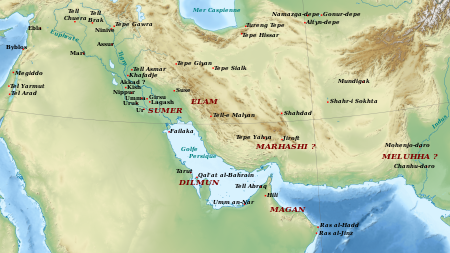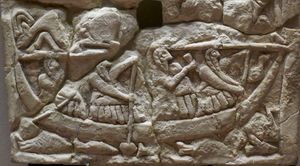ملوخا

مـِلوحــّـا Meluḫḫa أو ملوخــّـا (Melukhkha؛ Me-luh-haKI ؛𒈨𒈛𒄩𒆠) هو اسم سومري لشريك تجاري بارز لسومر أثناء العصر البرونزي الأوسط. التعرف عليه يبقى سؤالاً مفتوحاً، ولكن معظم الدارسين يقرنونه بـحضارة وادي السند.[4]
أصل الاسم
Asko Parpola identifies Proto-Dravidians مع حضارة وادي السند (IVC) and the Meluhha people mentioned in Sumerian records. According to him, the word "Meluhha" derives from the Dravidian words mel-akam ("highland country"). It is possible that the IVC people exported sesame oil to Mesopotamia, where it was known as ilu in Sumerian and ellu in Akkadian. One theory is that these words derive from the Dravidian name for sesame (el or ellu). However, Michael Witzel, who associates IVC with the ancestors of Munda speakers, suggests an alternative etymology from the para-Munda word for wild sesame: jar-tila.[مطلوب توضيح] Munda is an Austroasiatic language, and forms a substratum (including loanwords) in Dravidian languages.[5]
Asko Parpola relates Meluhha with Mleccha who were considered non-Vedic "barbarian" in Vedic Sanskrit.[6][7]
التجارة مع سومر

Sumerian texts repeatedly refer to three important centers with which they traded: Magan, Dilmun, and Meluhha. Magan is usually identified with Egypt in later Assyrian texts; but the Sumerian localization of Magan was probably Oman. Dilmun was a Persian Gulf civilization which traded with Mesopotamian civilizations, the current scholarly consensus is that Dilmun encompassed Bahrain, Failaka Island and the adjacent coast of Eastern Arabia in the Persian Gulf.[10][11]
There is extensive presence of Harappan seals and cubical weight measures in Mesopotamian urban sites. Specific items of high volume trade are timber and specialty wood such as ebony, for which large ships were used. Luxury items also appear, such as lapis lazuli mined at a Harappan colony at Shortugai (modern Badakhshan in northern Afghanistan), which was transported to Lothal, a port city in Gujarat in western India, and shipped from there to Oman, Bahrain and Sumer.
In the 1980s, important archaeological discoveries have been made at Ras al-Jinz (Oman), located at the easternmost point of the Arabian Peninsula, demonstrating maritime Indus Valley connections with Oman, and the Middle East in general.[12][13]
شبه القارة الهندية أَم أفريقيا؟

Writings in the Ur-III period describe Meluhha as the 'land of the black mountains'.[بحاجة لمصدر] Almost all scholars suggest that Meluhha was the Sumerian name for the Indus Valley Civilization.[بحاجة لمصدر] Finnish scholars Asko and Simo Parpola identify Meluhha (earlier variant Me-lah-ha) from earlier Sumerian documents with Dravidian mel akam "high abode" or "high country". Many items of trade such as wood, minerals, and gemstones were indeed extracted from the hilly regions near the Indus settlements. They further claim that Meluhha is the origin of the Sanskrit mleccha, meaning "barbarian, foreigner".[15]
Early texts (c. 2200 BC) seem to indicate that Meluhha is to the east, suggesting either the Indus valley or India.[بحاجة لمصدر] However, much later texts documenting the exploits of King Assurbanipal of Assyria (668–627 BC), long after the Indus Valley civilization had ceased to exist, seem to imply that Meluhha is to be found either in south India or in Africa, somewhere near Egypt.[16]
There is sufficient archaeological evidence for the trade between Mesopotamia and the Indian subcontinent. Impressions of clay seals from the Indus Valley city of Harappa were evidently used to seal bundles of merchandise, as clay seal impressions with cord or sack marks on the reverse side testify. A number of these Indian seals have been found at Ur and other Mesopotamian sites.[17][18]
The Persian-Gulf style of circular stamped rather than rolled seals, also known from Dilmun, that appear at Lothal in Gujarat, India, and Failaka Island (Kuwait), as well as in Mesopotamia, are convincing corroboration of the long-distance sea trade network, which G.L. Possehl has called a "Middle Asian Interaction Sphere".[19] What the commerce consisted of is less sure: timber and precious woods, ivory, lapis lazuli, gold, and luxury goods such as carnelian and glazed stone beads, pearls from the Persian Gulf, and shell and bone inlays, were among the goods sent to Mesopotamia in exchange for silver, tin, woolen textiles, perhaps oil and grains and other foods. Copper ingots, certainly, bitumen, which occurred naturally in Mesopotamia, may have been exchanged for cotton textiles and chickens, major products of the Indus region that are not native to Mesopotamia—all these have been instanced.
الفترة اللاحقة
في العصور الآشورية والهلينية، واصلت النصوص المسمارية استخدام (أو إعادة إحياء) أسماء الأماكن القديمة، giving a perhaps artificial sense of continuity between contemporary events and events of the distant past.[20] For example, Media is referred to as "the land of the Gutians",[21] a people who had been prominent around 2000 BC.
Meluhha also appears in these texts, in contexts suggesting that "Meluhha" and "Magan" were kingdoms adjacent to Egypt. Assurbanipal writes about his first march against Egypt, "In my first campaign I marched against Magan, Meluhha, Tarka, king of Egypt and Ethiopia, whom آسرحدون, king of Assyria, the father who begot me, had defeated, and whose land he brought under his sway." In the Hellenistic period, the term is sometimes used to refer to Ptolemaic Egypt, as in its account of a festival celebrating the conclusion of the Sixth Syrian War.[22]
These references do not necessarily mean that early references to Meluhha also referred to Egypt. Direct contacts between Sumer and the Indus Valley had ceased even during the Mature Harappan phase when Oman and Bahrain (Magan و دلمون) became intermediaries. After the sack of Ur by the Elamites and subsequent invasions in Sumer, its trade and contacts shifted west and Meluhha passed almost into mythological memory. The resurfacing of the name could simply reflect cultural memory of a rich and distant land, its use in records of Achaemenid and Seleucid military expeditions serving to aggrandize those kings.
انظر أيضاً
المراجع
- ^ "Cylinder Seal of Ibni-Sharrum". Louvre Museum.
- ^ "Site officiel du musée du Louvre". cartelfr.louvre.fr.
- ^ Brown, Brian A.; Feldman, Marian H. (2013). Critical Approaches to Ancient Near Eastern Art (in الإنجليزية). Walter de Gruyter. p. 187. ISBN 9781614510352.
- ^ McIntosh, Jane (2008). The Ancient Indus Valley: New Perspectives. p. 46. ISBN 978-1-57607-907-2.
- ^ McIntosh 2008, p. 354.
- ^ Parpola, Asko; Parpola, Simo (1975), "On the relationship of the Sumerian toponym Meluhha and Sanskrit mleccha", Studia Orientalia 46, http://ojs.tsv.fi/index.php/StOrE/article/view/49874/14912
- ^ Witzel, Michael (1999), "Substrate Languages in Old Indo-Aryan (Ṛgvedic, Middle and Late Vedic)" (PDF), Electronic Journal of Vedic Studies 5 (1), http://www.ejvs.laurasianacademy.com/ejvs0501/ejvs0501article.pdf
- ^ Parpola, Asko (2015). The Roots of Hinduism: The Early Aryans and the Indus Civilization (in الإنجليزية). Oxford University Press. p. 353. ISBN 9780190226930.
- ^ "Meluhha interpreter seal. Site officiel du musée du Louvre". cartelfr.louvre.fr.
- ^ "Prehistory and Protohistory of the Arabian Peninsula: Bahrain". M. A. Nayeem. 1990. p. 32.
- ^ "Sa'ad and Sae'ed Area in Failaka Island". UNESCO. Retrieved 21 July 2013.
- ^ Maurizio Tosi: Die Indus-Zivilisation jenseits des indischen Subkontinents, in: Vergessene Städte am Indus, Mainz am Rhein 1987, ISBN 3805309570, S. 132-133
- ^ Story of Ras Al Jinz. Oman Information
- ^ "The Indus Civilization and Dilmun, the Sumerian Paradise Land". www.penn.museum.
- ^ Parpola, Asko; Parpola, Simo (1975). "On the relationship of the Sumerian Toponym Meluhha and Sanskrit Mleccha". Studia Orientalia. 46: 205–238.
- ^ Hansman, John (1973). "A "Periplus" of Magan and Meluhha". Bulletin of the School of Oriental and African Studies, University of London. 36 (3): 554–587. doi:10.1017/s0041977x00119858.
- ^ "urseals". hindunet.org. Archived from the original on 2000-12-11.
- ^ John Keay (2000). India: A History. p. 16.
- ^ Possehl, G.L. (2007), “The Middle Asian Interaction Sphere”, Expedition 49/1
- ^ Van De Mieroop, Marc (1997). The Ancient Mesopotamian City. Oxford: Clarendon Press. p. 44.
- ^ Sachs & Hunger (1988). Astronomical Diaries & Related Texts from Babylonia, vol.1. Vienna: Verlag der Österreichischen Akademie der Wissenschaften. pp. –330 Obv.18.
- ^ Sachs & Hunger (1988). Astronomical Diaries & Related Texts from Babylonia, vol.2. Vienna: Verlag der Österreichischen Akademie der Wissenschaften. pp. –168 A Obv.14–15.
ببليوگرافيا
- McIntosh, Jane R. (2008). The Ancient Indus Valley : New Perspectives. Santa Barbara, California: ABC-CLIO. ISBN 9781576079072.
{{cite book}}: Invalid|ref=harv(help) - Julian Reade (ed.) The Indian Ocean in Antiquity. London: Kegan Paul Intl. 1996
وصلات خارجية
- Meluhha and Agastya : Alpha and Omega of the Indus Script by Iravatham Mahadevan
- Articles containing سومرية-language text
- جميع الصفحات التي تحتاج تنظيف
- مقالات بالمعرفة تحتاج توضيح from October 2019
- Articles with hatnote templates targeting a nonexistent page
- Articles with unsourced statements from November 2017
- Articles with unsourced statements from April 2015
- سومر
- آسيا العصر البرونزي
- الشعوب القديمة في الهند
- الشعوب القديمة في پاكستان
- الهند قبل التاريخ
- حضارة وادي السند
- آثار الهند
- آثار پاكستان

